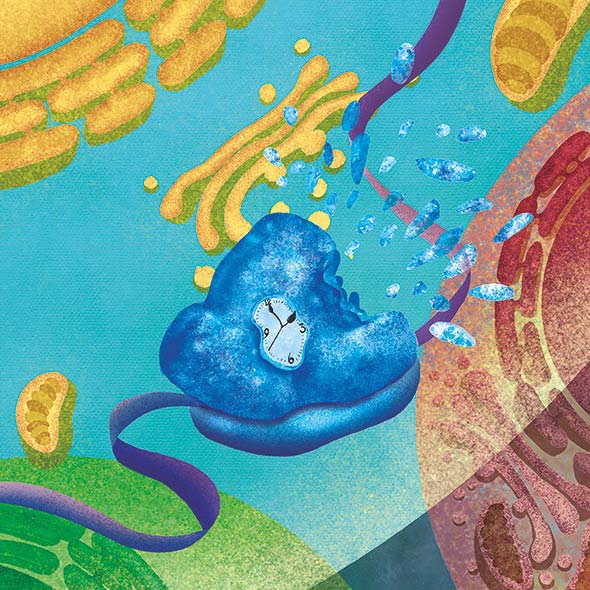 Aging impairs the ability of ribosomes to efficiently synthesize proteins and leads to protein misfolding and aggregation, which disrupts cellular health and is a hallmark of many age-related diseases. (Image credit: Felipe Serrano)
Aging impairs the ability of ribosomes to efficiently synthesize proteins and leads to protein misfolding and aggregation, which disrupts cellular health and is a hallmark of many age-related diseases. (Image credit: Felipe Serrano)Aging leads to a decline in cellular fitness and loss of optimal protein function. Many age-related ailments, including Alzheimer’s and Parkinson’s diseases, are caused by protein aggregation, a result of errors in protein folding. Yet, the mechanisms underlying how ageing causes proteins to aggregate has largely remained a black box. In new research published Jan. 19 in Nature, researchers at Stanford University have traced this problem to age-dependent impairment of the machinery that produces new proteins.
To root out this issue, researchers in the lab of Judith Frydman, the Donald Kennedy Chair in the School of Humanities and Sciences at Stanford, focused on how age affects the functioning of ribosomes – the cellular machinery responsible for converting messenger RNA into proteins. They used two well-established models of human aging, yeast and roundworms. Through a combination of experiments and computational data analysis, they found that ribosome function degrades with age in both organisms. The increased load of defective proteins with age overwhelms the protective quality control failsafes that would otherwise prevent protein aggregation.
“We’ve known that protein aggregation with age is a problem linked to many diseases. At the moment, treatments try to address it by trial-and-error testing,” said Kevin Stein, lead author of the paper and a former postdoctoral scholar in the Frydman Lab. “Getting down to the basic-biology of these diseases, and understanding what mechanisms cause them, can help us make better decisions about what therapies could be effective before we test them.”
A vulnerable time
When folded correctly, proteins carry out their functions and remain soluble in the environment of the cell. Misfolded proteins, by contrast, cannot function properly and tend to stick to each other and other proteins, clogging up cellular processes and generating toxic aggregates. Protein aggregation has been specifically implicated in a wide variety of aging-linked diseases, including Alzheimer’s, Parkinson’s, frontotemporal dementia, Huntington’s disease and ALS (amyotrophic lateral sclerosis).
To guard against the continual production of misfolded proteins, cells have dedicated “quality control” machinery for fixing or degrading misfolded proteins. Previous research has shown that shortcomings in these processes can lead to aggregation. This research is the first to show the folding defect during ageing starts early in the journey of a protein, when it is made by the ribosome. Because ribosomes are constantly producing large amounts of proteins, these defects cause a subsequent snowball of disfunction.
“One of the most vulnerable and key times in the life of a protein – where it’s most prone to misfolding – is when it’s made,” said Frydman, who is a professor of biology and of genetics.
To start, the researchers used a technique called ribosome profiling, which allowed them to see exactly how ribosomes are moving on the messenger RNA during the act of translation. Amassing data from all the genes translated in young and aged Caenorhabditis elegans roundworms and yeast, the researchers noticed that in older cells ribosomes periodically moved more slowly and were more likely to stall and bump into each other. As one might expect, the researchers saw that decreases in proper ribosome performance aligned with increases in the aging-dependent aggregation of misfolded proteins. One important insight was that the increase in stalling and misfolding overwhelmed the cell’s cleaning-up-and-clearing-out quality control failsafes.
“There is a two-pronged situation where aging leads to increased stalling and increased ribosome collisions, but the cell loses the safety net to deal with it,” explained Stein.
In follow-up experiments in worms, the researchers found that even if the overall fraction of newly made proteins with altered translation during aging is low (~10%), this small effect can still be enough to overwhelm the quality control system and trigger significant aggregation that can disrupt many different cellular components or processes.
“Every cell normally makes millions of these newly translated proteins,” said Frydman. “So very slight changes in the efficiency of folding with age will escalate in a vicious cycle where defects in translation lead to an overload of the system, which in turn leads to increased protein aggregates with age that are themselves also toxic.”
To make matters worse, through further experiments in yeast and C. elegans, the researchers showed that these problems affect the very proteins that cells use to aid in translation and to help correct misfolding issues.
Millions of questions
While this research revealed, for the first time, some intriguing insights about the mechanisms of aging, it inspires many questions for the future. Perhaps the most pressing one: Why does aging affect ribosomes? Also, what can be done about it?
Given the similarities between ageing in yeast, C. elegans and other organisms, the researchers are optimistic that their findings will translate also to humans. One direction for future work will be the application of insights from this study to the development of possible treatments for age-related diseases associated with protein aggregation. Excitingly, the study showed that analysis of mutations that extend lifespan “rejuvenated” ribosomal function in aged yeast.
“This is only the beginning of a very fascinating future,” said Fabián Morales-Polanco, a co-author of the research and a postdoctoral scholar in the Frydman lab. “We set a precedent for something new, and there are millions of questions – and probably hundreds of papers – that will follow.”
BY TAYLOR KUBOTA
news.stanford.edu


